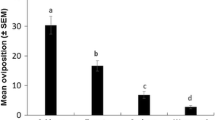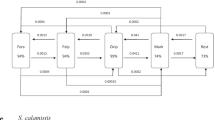Abstract
A study was made of neonate larvae of Phthorimaea operculella.Host finding from soil-laid eggs and dispersal from hosts and nonhosts were first examined. Of first-instar larvae hatching from soil-laid eggs, 80% found the potato plant while roughly 50% found each of the other three plants (datura, tobacco, and tomato). Dispersal from potato, datura, and tobacco was very low, while on tomato it was higher and a high mortality was observed in the 24 h period. Dispersal from nonhost plants was high. Behavior on leaves of hosts and non-hosts is described and some host-plant specific behaviors are identified. Effects on behavior of some of the physical and chemical factors are described. Methylene dichloride extracts of potato leaf wax reduced locomotion rates and the number of turns during locomotion. Also methylene dichloride extract and, to a lesser extent, methanol extract caused biting behavior.
Similar content being viewed by others
References
Attia, R., and Mattar, B. (1939). Some notes on the potato tuber moth.Ministry Agr. Egypt. Entomol. Sect. Bull. 216.
Balachowsky, A. S., and Real, P. (1966). La teigne de la pomme de terre.In A. S. Balachowsky (ed.),Entomologie appliquee à l'agriculture, Tome II, Lepidoptères, Vol. i, pp. 371–381.
Bernays, E. A., Woodhead, S., and Haines, L. (1985). Climbing by newly hatched larvae of the spotted stalk borerChilo partellus to the top of sorghum plants.Entomol. Exp. Appl. 39: 73–79.
Chapman, R. F. (1977). The role of the leaf surface in food selection by Acridis and other insects.Coll. Int. CNRS 265: 133–149.
Cunningham, I. C. (1969). Alternative host plants of tobacco leaf-miner (Phthorimaea operculella (Zell.)).Queensland J. Agr. Anim. Sci. 26: 107–111.
Etzel, L. K. (1985).Phthorimaea operculella. In Singh, P., and Moore, R. F. (eds.),Handbook of Insect Rearing, Vol. II, pp. 431–442.
Finney, G. L., Flanders, S. E., and Smith, H. S. (1947). Mass culture ofMacrocentus ancylivorus and its host, the potato tuber moth.Hilgardia 17: 437–483.
Gibson, R. W. (1976). Trapping of the spider miteTetranychus urticae by glandular hairs on the wild potatoSolanum berthaultii.Potato Res. 19: 179–182.
Johnson, B. (1956). The influence on aphids of the Glandular hairs on tomato plants.Plant Pathol. 5: 131–132.
Simmonds, N. W. (1971). The potential of potatoes in the tropics.Trop. Agr. 48: 291–301.
Trouvelot, B. (1924). Recherches de biologie apliquè sur la teigne des pommes de terre et ses parasites et considerations generales sur l'utilisation des insectes entomophages en agriculture. Etude des conditions de pullulation des insectes.Ann. Epiphyt. 10: 1–132.
Author information
Authors and Affiliations
Rights and permissions
About this article
Cite this article
Varela, L.G., Bernays, E.A. Behavior of newly hatched potato tuber moth larvae,Phthorimaea operculella Zell. (Lepidoptera: Gelechiidae), in relation to their host plants. J Insect Behav 1, 261–275 (1988). https://doi.org/10.1007/BF01054525
Accepted:
Issue Date:
DOI: https://doi.org/10.1007/BF01054525




